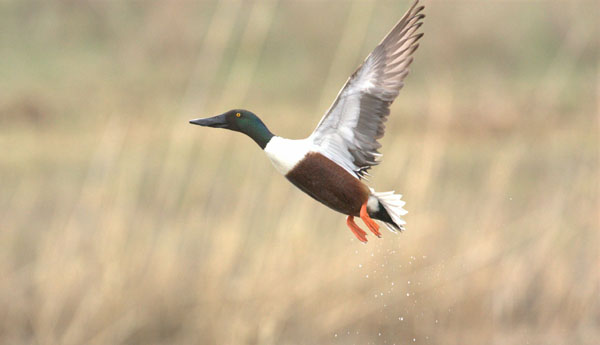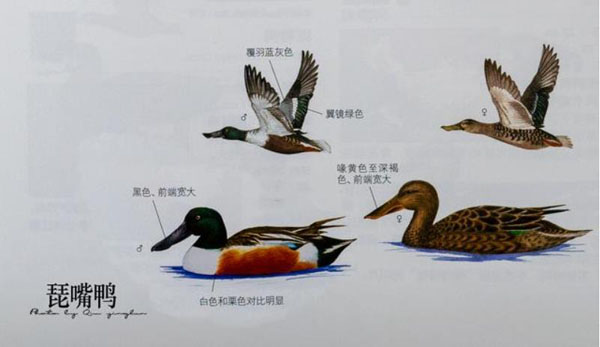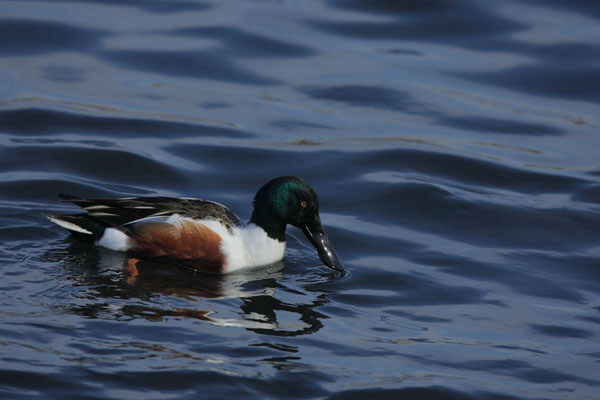Spatula clypeata
IUCN
LCBasic Information
Scientific classification
- name:Spatula clypeata
- Scientific Name:Shovel duck, Broad-billed duck,Anas clypeata,Northern Shoveler
- Outline:Waterfowl
- Family:Anseriformes Anatidae Duck
Vital signs
- length:43-51cm
- Weight:About 0.5 kg
- lifetime:21years
Feature
The mouth is large and flat, with the tip expanded into a shovel shape, and its shape is very special.
Distribution and Habitat
In China, it breeds in the northwest and northeast, and winters in the waters south of the Qinling Mountains, including Taiwan Island and Hainan Island. Abroad, it breeds in the north-central part of the Holarctic, and winters in the southern part of the Holarctic, South Asia, Southeast Asia, northern Africa, and Central America.
It inhabits rivers, lakes, ponds, swamps and other water environments in open areas. It also appears in mountain rivers, plateau lakes, small ponds, coastal swamps and estuaries, and also appears in sewage ponds and paddy fields near villages and towns.
Appearance
A medium-sized river duck with an elongated bill and a spoon-shaped tip, which distinguishes it from other ducks. The male has a dark green head with a purple sheen, a white chest and flanks, a chestnut-red underbelly, a black tail, large blue-gray patches on the wings, and green wings. The female is brown-brown with scaly spots, a dark eye pattern, and green wings. The iris of the male is yellow, while the female is brown. The male's bill is gray-black, while the female's is orange-yellow with brown tints, and the feet are orange-red.
Details
Shoveler ducks often travel in pairs or small groups of 3-5, and can also be seen moving alone. They also gather in larger groups during the migration season. They often move and forage in muddy ponds and shallow waters. They often roam in shallow waters near the water, and are extremely cautious. If they find people, they will immediately stop moving and look around. If there is danger, they will immediately swim away or suddenly take off from the water. They are not strong in flying ability, but they fly fast and powerfully, and often make a "whoosh" sound from the vibration of their wings. When swimming, the back is high and the front is low, and the bill often touches the water surface. The speed is not very fast but very light. Sometimes they also walk on the shore or in shallow water, but their movements are clumsy and slow.

It mainly feeds on animal food such as snails, mollusks, crustaceans, aquatic insects, fish, frogs, and also eats plant food such as algae and grass seeds. The main way of foraging is to dig in the mud with its shovel-shaped mouth in shallow water or swamps. It can forage while swimming or walking. When swimming, the mouth swings back and forth on the water surface, and can collect food by filtering water on the water surface. But most of the time, it puts its head and neck into the water to dig food in the muddy bottom of shallow water, and sometimes even stands upright in the water with its tail facing up, and puts its head into the water to find food. Foraging is mainly carried out during the day, and when resting, they are mostly concentrated on the shore or bank close to the foraging waters.

Shoveler is a migratory bird. It arrives in North China from mid-March to early April every year, and arrives in the northern part of Northeast China and Changbai Mountain from mid-April to late April. In autumn, it returns to the wintering grounds south of the Yangtze River via North China from late September to late October.

The Shoveler is one of China's traditional hunting birds. Due to hunting and deteriorating environmental conditions, its number is very small. According to the Asian Midwinter Waterbird Survey organized by the International Waterfowl Research Bureau in 1992, the population in China is 23,910, 35,549 in West Asia, 304,619 in South Asia, 27,165 in East Asia, and 976 in Southeast Asia. In North America, according to a survey in 1960, there are about 2 million. In the Western Palearctic, according to a survey in 1975, there are about 1.5 million. The global population is about 2.8 million.








